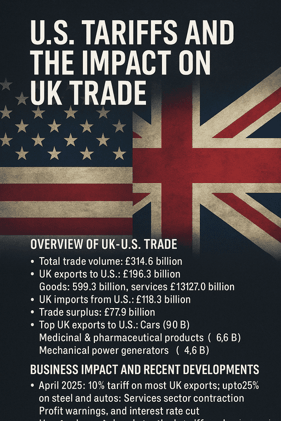Navigating U.S. Tariffs: Impact on UK–U.S. Trade in 2025
Introduction
As the United States intensifies its tariff policies under President Donald Trump’s administration, the ripple effects are being felt across the Atlantic. The United Kingdom, as one of America’s largest trading partners, now faces a complex web of challenges and opportunities. This article explores the current trade dynamics between the UK and the U.S., the impact of new tariffs, and what lies ahead for businesses and policymakers.
 I. UK–U.S. Trade Snapshot (2024 Data)
I. UK–U.S. Trade Snapshot (2024 Data)| Metric | Value |
|---|---|
| Total Trade Volume | £314.6 billion |
| UK Exports to U.S. | £196.3 billion |
| — Goods | £59.3 billion |
| — Services | £137.0 billion |
| UK Imports from U.S. | £118.3 billion |
| — Goods | £57.1 billion |
| — Services | £61.2 billion |
| Trade Surplus (UK) | £77.9 billion |
Top UK Exports to the U.S.:
- Cars (£9.0B, +39.4%)
- Medicinal & pharmaceutical products (£6.6B, -25.1%)
- Mechanical power generators (£4.6B, -11.3%)
- Scientific instruments (£2.4B, -11.6%)
- Aircraft (£2.2B, +5.3%)
Top UK Imports from the U.S.:
- Crude oil (£8.7B, +2.5%)
- Mechanical power generators (£5.8B, +5.1%)
- Refined oil (£4.0B, +17.5%)
- Medicinal & pharmaceutical products (£4.0B, +5.0%)
- Aircraft (£3.1B, -1.5%)
II. The New U.S. Tariffs and Their Scope
| Category | Details |
| General Tariff | 10% baseline tariff on UK exports. |
| Sector-Specific Tariffs | Up to 25% on steel and automobiles. |
| Cultural Products | 100% tariff on UK-produced films. |
These tariffs, part of broader measures applied to 185 countries, aim to protect U.S. domestic industries and recalibrate trade imbalances. However, they have introduced significant costs and uncertainties for UK businesses reliant on U.S. markets.
-
Rising Costs and Profit Warnings
-
26 UK-listed companies issued profit warnings in April 2025 alone—a 24% increase year-on-year.
-
Many cited U.S. tariffs and the resulting economic uncertainty as primary factors.
-
-
Sector-Specific Challenges
-
Automotive: UK car exports surged before tariffs took effect but now face declining U.S. demand due to cost increases.
-
Film Industry: The 100% tariff on UK films threatens a vital export market and collaborations with Hollywood studios.
-
Services Sector: Experienced its first contraction in 17 months amid reduced demand and trade uncertainty.
-
-
Interest Rates and Economic Strategy
-
The Bank of England is expected to cut interest rates by 0.25 percentage points to 4.25% to counteract the slowdown.
-
In response to escalating tariffs, the UK and U.S. governments have initiated negotiations to:
-
Reduce or eliminate tariffs on key sectors like steel and automobiles.
-
Establish a framework to prevent future trade disruptions.
While an agreement is anticipated, it is expected to primarily address recent tariff hikes rather than create a full free trade area.
-
Diversify Export Markets
-
Reduce dependency on the U.S. by targeting alternative markets in the EU, Asia, and the Middle East.
-
-
Strengthen Domestic Supply Chains
-
Minimize exposure to transatlantic supply chain shocks.
-
-
Engage in Policy Advocacy
-
Collaborate with industry groups and government bodies to influence trade negotiations.
-
-
Enhance Currency Risk Management
-
Protect profit margins against exchange rate volatility amid trade negotiations.
-
VI. Looking Ahead: Opportunities Amidst Challenges
While the current tariff environment presents formidable challenges, it also offers opportunities for innovation and strategic pivots. UK businesses that proactively adapt—whether through market diversification, supply chain resilience, or advocacy—can not only weather the storm but emerge stronger.
Moreover, the ongoing UK–U.S. trade negotiations underscore the potential for long-term solutions that could foster greater stability and predictability in transatlantic trade.
Conclusion
The UK–U.S. trade relationship remains one of the most significant bilateral economic partnerships globally. However, 2025’s tariff regime has introduced volatility that demands swift adaptation and strategic foresight from businesses and policymakers alike. As negotiations progress and markets adjust, staying informed and agile will be essential for navigating this new era of transatlantic commerce.
- UK Government Trade and Investment Factsheet (May 2025)
- The Times UK
- Reuters
- AP News
- New York Post
- Business Insider
- Al Jazeera




